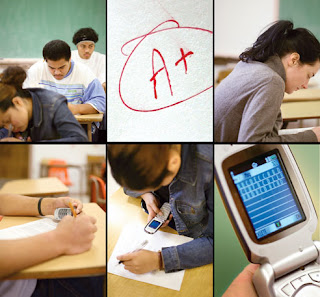Are you failing your in-class writing tests because of your grammar and
mechanics mistakes? Is it your own fault because you didn't leave
yourself enough time to proofread - even once. You CAN help yourself.
Here are some tips to help you learn how proofread quickly and
efficiently even when you are under pressure. If you follow this advice,
you will definitely improve your writing scores.
1. Get To Know Your Own Errors
Knowledge is power. Get to know the mistakes YOU make most frequently. Analyze all your previous in-class writing tests and read your instructor's comments Look for the type of mistakes you usually make and count the number of times you make them. Make a list of errors starting with the most serious and the most frequent and moving to less serious and less frequent.
2. Make sure you understand why you made your errors
Determine whether your errors are careless mistakes ordue to lack of knowledge. It is easy to edit ( correct) carless mistakes when you proofread, but you need to learn more about the ones you make because you didnd't understand the rule. If you don't know or understand the rule, talk to your instructor or a tutor the learning centre. Get some direction about where you can learn more and practice. Using your list of most
important errors, write rules and sample sentences in your notebook or in the
back of your dictionary.
3. Focus on your most frequent errors
Know your list of frequent errors so that you know what to took for when you are proofreading . For example, your list might consist of the following: verb tenses, modals, subject-verb agreement, plurals, word order, sentence fragments and run on sentences.
4. Get ready even before you write
Place your list of most frequent errors on a post-it note on your desk while your are writing. This will remind you to proofread for these ererors,and may even help you to avoid making some of them as you write.
5. Be disciplined. Don't overwrite
Be
disciplined. Create a time line for
your writing and proofreading and stick to it. Leave yourself at least 20 minutes to proofread if you have a 90 minute writing period. If you tend to overwrite, force yourself to keep it simple. Remember LONGER IS NOT ALWAYS BETTER. The more you write, the more errors you will make and the less time you will have to correct them.
6. Make sure you leave time to proofread
Check the time often. Make
sure you are sticking to your timeline. If you see that you only have
20 minutes left, start wrapping things up.
 7.7. Proofread four or five times.
7.7. Proofread four or five times.
You cannot check everything in one reading. You are too familiar with the material and you will end up reading for meaning. You wonèt know where to focus your efforts, and will miss obvious errors.
8. Proofread for one type of error at a time.
Proofread for ONE type of error at a time. Start
with the errors you make most frequently. If you try to look for too many hings at once, you risk losing focus. It's easier to locate grammar mistakes if you aren't trying to catch punctuation or spelling errors at the same time. Besides, some of the techniques that work well for one type of mistake don't work as well for another type error.
9. Proofread out loud - or at least loudly enough so that you can hear.
Your
ears often catch mistakes your eyes will not. Reading out loud forces you to actually say each word and lets you ear how the words sound together. Listening to your words and sentences will allow you to notice missing words such as subjects, or “be”verbs. It will help you realize that you should be using a gerund instead of an infinitive. Hearing how the words sound together will also help you realize your word order is wrong, or that you are writing a Chinglish, or Spanglish phrase or sentence rather than an English one.
10.Read each word and sentence as slowly as you can
Try to s-l-o-w-d-o-w- n as you read. If you read silently, or at normal speed, you may skip over errors, make unconscious corrections, or simply overlook them bedcause you are too familiar with the content. You won't give your eyes, or your ears enough time to spot, or hear the errors. Reading s-l-o-w-l-y forces you to concentrate on the task of proofreading.
 11
11.
Read you paper backward
Read from the last sentence to the first sentence, one word, or one sentence at a time. This helps you concentrate on sentences and words rather than on meaning, or on the paper as a whole.It is a helpful strategy to check for both sentence fragments and spelling.
12. Cover all but one one sentence
Use a piece
of white paper to cover every thing except for the sentence you are
reading. This helps reduce visual noise (all the other surrounding
words), and helps you from being distracted by other sentences. As you
read each word and sentence separately, it is much easier to find
individual grammar, punctuation or spelling errors.
13. Circle every puncutation mark This forces you to look at each one. As you circle, ask
yourself if the punctuation is correct. "Should this be a period? Is
there a complete idea, or it it only half an idea?" Ask yourself if this
should be a comma, a period, or a connecting word? Do you see several
ideas that only seem to be connected with a comma? Are you using commas
where they don't belong?
14. Don't get discouraged Learing how to proofread effectively is a learning process. It takes time to get
good at it. You won't find every mistake, but if you follow these
strategies, you will locdate and be able to correct many of your
careless mistakes. That alone will make an enormous difference in your
marks. It will also show your instructor that you care about cleaning up
your paper before you hand it in.
Proofreading can make the difference between passing or failing. Isn't it worth making the effort?
My next post will focus on the most common ESL errors to proofread for and correct.
Can you add any tips I may have missed? Let me know in the comment box.




 7.
7.












